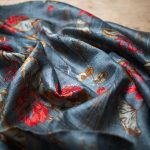When you're considering the best fabrics for various printing techniques, it's crucial to understand how each fabric interacts with different methods. For instance, cotton's softness makes it a prime candidate for screen printing, while polyester shines in sublimation. But what about blends or eco-friendly options? Each choice can significantly impact the final product's quality and durability. As you weigh your options, think about how these fabrics can affect not just the appearance, but also the longevity of your prints. You might be surprised by some of the alternatives that could better suit your needs.
Table of Contents
Key Takeaways
- Cotton is versatile for various printing techniques, offering excellent color absorption and softness, making it ideal for apparel.
- Polyester is lightweight, durable, and quick-drying, making it suitable for athletic wear and outdoor graphics.
- Organic fabrics, such as organic cotton and hemp, are sustainable options that provide stunning prints while being eco-friendly.
- Blends of polyester with cotton or spandex enhance durability and comfort, making them popular choices for diverse applications.
Screen Printing Fabrics
When choosing fabrics for screen printing, you'll want materials that offer both durability and a smooth surface for vibrant ink adhesion.
Cotton is one of the best choices, as it's not only affordable but also has a natural softness that allows ink to settle evenly. Look for 100% cotton or cotton blends, as they hold colors well and withstand multiple washes, ensuring your designs last.
Polyester is another excellent option, especially for athletic wear. It's lightweight, quick-drying, and resistant to shrinking, making it ideal for performance fabrics. However, keep in mind that polyester can be trickier to print on due to its slick surface, so using the right inks is crucial.
If you're aiming for a more eco-friendly approach, consider organic cotton or hemp fabrics. These materials are sustainable and can produce stunning prints, though they might come at a higher cost.
Lastly, stay away from stretchy materials like spandex unless you're using specific techniques to accommodate the stretch.
Choose the right fabric, and you'll set yourself up for successful, eye-catching screen prints that stand the test of time.
Digital Printing Materials
For digital printing, you'll want to select fabrics that not only showcase vibrant colors but also ensure smooth ink transfer for high-quality results. The choice of material plays a significant role in how your designs will appear and hold up over time.
Here are some of the best digital printing materials you should consider:
- Cotton: Offers excellent color reproduction and a soft feel, making it ideal for apparel.
- Polyester: Known for its durability and vibrant colors, polyester is great for outdoor banners and graphics.
- Canvas: Provides a sturdy surface perfect for artwork and photography prints.
- Silk: Delivers a luxurious finish and rich color depth, suitable for high-end fashion items.
When choosing your fabric, keep in mind its weight, texture, and intended use. Each material interacts differently with digital inks, so always test samples before committing to a larger print run.
Sublimation-Compatible Textiles
When it comes to sublimation printing, polyester fabrics are your best bet due to their ability to absorb and showcase vibrant colors.
You might also consider blends that combine polyester with other materials, as they can offer unique textures and added durability.
Let's explore the advantages of these textiles and how they can elevate your printing projects.
Polyester Fabric Advantages
Polyester fabric stands out as the top choice for sublimation printing due to its excellent color vibrancy and durability. When you choose polyester, you're opting for a material that can truly showcase your designs. This fabric not only holds colors brilliantly but also withstands the test of time, making it ideal for various applications.
Here are some key advantages of using polyester fabric for sublimation:
- Vibrant Colors: The dye bonds seamlessly with the fibers, resulting in striking, long-lasting colors.
- Durability: Polyester resists wear and tear, ensuring your prints remain intact over time.
- Moisture-Wicking: It effectively pulls moisture away from the body, making it perfect for activewear.
- Lightweight: The fabric is typically lightweight, contributing to comfort and ease of wear.
Blends for Sublimation Printing
Blends that incorporate polyester often yield excellent results in sublimation printing, combining the best properties of multiple fabrics to enhance color vibrancy and durability. When you're choosing a fabric blend, look for those that contain at least 50% polyester; this ensures optimal dye absorption and prevents fading over time.
Polyester-cotton blends are particularly popular, offering the comfort of cotton while maintaining the durability and colorfastness of polyester. This combination allows your prints to pop while keeping the fabric soft and breathable.
Another great option is polyester-spandex blends, which provide stretch and flexibility, making them ideal for activewear and fitted garments.
You might also consider using polyester-rayon blends, which offer a luxurious feel while still being sublimation-friendly. These blends can give your prints a unique drape and texture, adding visual interest to your designs.
When experimenting with blends, always test your fabric to ensure it meets your quality standards and printing requirements. Ultimately, the right blend will elevate your sublimation projects, delivering stunning results that stand out in both color and durability.
Best Fabrics for Heat Transfer
Choosing the right fabric for heat transfer is crucial, as it directly impacts the quality and durability of your prints. When selecting materials, you want to ensure they withstand the heat and pressure of the transfer process while still looking great.
Here are some of the best fabrics for heat transfer:
- Cotton: It absorbs heat well and provides vibrant colors, making it a popular choice.
- Polyester: This synthetic fabric is durable and offers excellent color retention, ideal for long-lasting designs.
- Cotton-Poly Blends: Combining the best of both worlds, these blends often yield great results in both comfort and print quality.
- Spandex: If you're looking for stretch, spandex works well for athletic wear, but be cautious with heat settings.
When using these fabrics, make sure to adjust your heat transfer settings accordingly. A successful transfer not only enhances your design but also ensures it stands the test of time, so choose wisely!
Eco-Friendly Printing Options
If you're looking for sustainable options, eco-friendly printing techniques offer a great way to reduce environmental impact while still achieving vibrant designs. You can choose water-based inks, which are less harmful than solvent-based alternatives. These inks use water as a primary solvent, cutting down on volatile organic compounds (VOCs) that contribute to air pollution.
Organic fabrics like cotton, hemp, and bamboo are excellent choices for eco-friendly printing. They're cultivated without harmful pesticides and chemicals, making them better for the environment. When you select these materials, you're supporting sustainable farming practices.
Another option is using recycled fabrics, which help reduce waste and promote circular economy practices. By printing on recycled textiles, you not only give new life to old materials but also minimize the need for new resources.
Consider digital printing as well, as it typically uses less ink and energy than traditional methods. It allows for on-demand production, limiting overproduction and waste.
Textiles for Direct-to-Garment
When it comes to direct-to-garment printing, cotton stands out for its exceptional print quality.
You might also consider blends that enhance durability, ensuring your designs last longer.
Let's explore how these fabrics can elevate your printing projects.
Cotton's Print Quality
Cotton offers excellent print quality for direct-to-garment techniques, showcasing vibrant colors and sharp details that elevate your designs. When you choose cotton, you're not just opting for a popular fabric; you're ensuring that your prints stand out. The natural fibers of cotton absorb ink beautifully, resulting in stunning prints that display your artwork in the best light.
Here are some benefits of using cotton for your direct-to-garment printing:
- Vibrant Colors: The fabric's natural absorbency allows for rich, deep colors.
- Sharp Details: Cotton captures intricate designs with precision, ensuring your artwork looks crisp.
- Soft Feel: It provides a comfortable texture that customers love to wear.
- Breathability: Cotton's natural properties make it suitable for all-day wear, enhancing its appeal.
Blends for Durability
Choosing fabric blends enhances durability in direct-to-garment printing, ensuring your designs withstand wear and tear. Blended fabrics typically combine the strengths of different materials, like cotton and polyester, to create a robust final product. This combination not only improves longevity but also maintains print quality, giving you the best of both worlds.
Here's a quick overview of common blends and their benefits:
| Blend Type | Durability Benefits | Print Quality |
|---|---|---|
| Cotton-Polyester | High abrasion resistance | Excellent color retention |
| Cotton-Rayon | Soft feel, less fading | Smooth finish |
| Polyester-Spandex | Stretch and recovery | Vibrant colors |
| Cotton-Modal | Breathable and soft | Good detail retention |
When you choose the right blend, your apparel can endure frequent washing and daily wear without losing its charm. Look for blends that suit your specific needs, and you'll find that durability doesn't have to compromise style. With the right fabric, your designs can truly shine!
Choosing Fabric for Mixed Techniques
Selecting the right fabric for mixed techniques can significantly enhance the final outcome of your printed projects. Whether you're combining screen printing with embroidery or sublimation, the fabric choice matters.
Here are some key factors to consider:
- Compatibility: Ensure the fabric works well with your chosen printing methods.
- Weight: Heavier fabrics may affect the print's appearance and durability.
- Texture: Textured fabrics can add dimension but may complicate the printing process.
- Color: Light fabrics often provide better contrast for vibrant prints.
Frequently Asked Questions
Can I Print on Stretchy Fabrics Like Spandex?
Yes, you can print on stretchy fabrics like spandex, but you'll need special inks and techniques to ensure the design adheres well and maintains flexibility. Experimenting with different methods will help achieve the best results.
What Is the Best Fabric for Outdoor Printing Durability?
For outdoor printing durability, you'll want to choose materials like polyester or canvas. These fabrics resist fading and weather damage, ensuring your prints maintain their vibrant colors and integrity even in harsh conditions.
How Do I Avoid Ink Bleeding on Fabrics?
To avoid ink bleeding on fabrics, ensure you're using the right type of ink for the material. Pre-treat the fabric if necessary, and maintain optimal printing conditions like temperature and humidity.
Are There Fabrics Suitable for Both Screen and Digital Printing?
Yes, you can use fabrics like cotton, polyester, and cotton-poly blends for both screen and digital printing. They offer great color retention and detail, making them versatile choices for various printing techniques you're considering.
Which Fabrics Are Best for High-Resolution Printing?
For high-resolution printing, you'll want to choose fabrics like cotton sateen or polyester. They offer smooth surfaces that capture intricate details beautifully, ensuring your designs look sharp and vibrant. Don't forget to test samples!
- Tetron Fabric for Marine Applications: Durability and Use Cases - June 18, 2025
- Tetron Fabric for Outdoor Furniture: Weather Resistance and Care - June 18, 2025
- Tetron Fabric for Wall Coverings: Style and Application Tips - June 18, 2025






